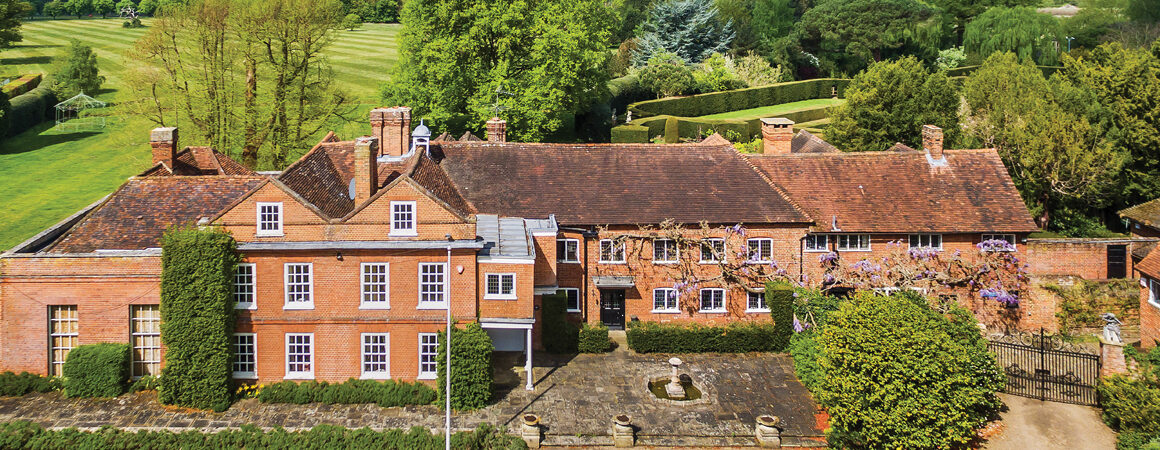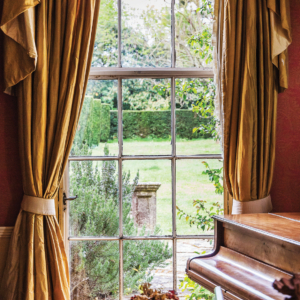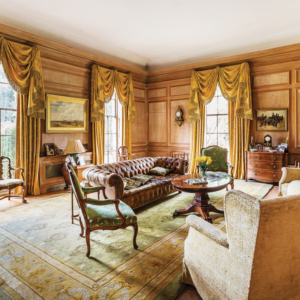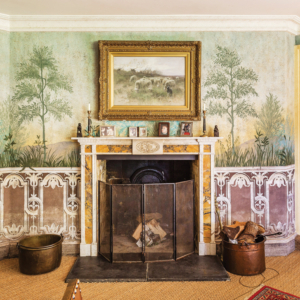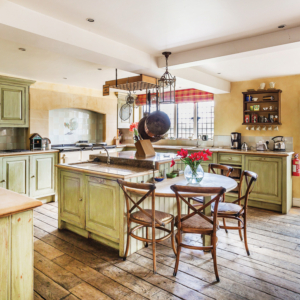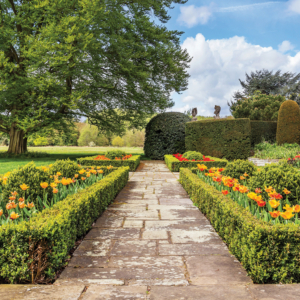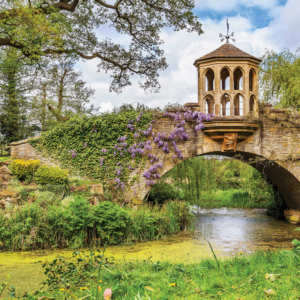Welcome to Dunsborough Park
How rare a find on the open market is a place like Dunsborough Park? You could spend a lifetime looking for such an estate – one with 100 acres of gardens that are so unfeasibly magnificent you could imagine HRH seeing these photographs and asking her gardener why Balmoral’s not in the same league.
Dunsborough Park’s recorded history goes back to the 12th century, but the house on the current site was originally a 17th century farmhouse. Over the centuries – and particularly in the 19th century, when owned by the Onslow family – much had been added and modified.
The eight-bedroom house itself has some magnificent, striking features within, particularly its principal reception rooms.There’s a drawing room with floral silk and cotton wall covering, marble fireplace and full height windows; the dining room is just as grand, with a marble fireplace and hand-painted hessian wallpaper imported from Italy.
There are traditional features including exposed beams, while more modern touches include a conservatory. It’s the newest of Dunsborough’s additions, having been added by the current owners as a perfect spot from which to overlook the garden and parkland.
It’s easy to see why they added it as the garden and parkland in question is truly astounding. The gardens owe a great deal to Oliver Simmonds, an MP who bought the property in the 1930s. It was he who had the Tudor style gatehouse at the entrance built, as well as the octagonal pumphouse, the bridge, pavilion, greenhouses and ha-ha.
After the war the gardens fell into decline until 1994 when the current owners, Baron Dolf and Baroness Caroline Sweerts de Landas Wyborgh, bought the place.
Beyond those gardens, the estate contains far more: 10 further cottages, tennis courts, garages and at one end of the house there is a space referred to as the ‘concert hall’, complete with high ceiling and viewing gallery. It’s also a perfect property for horse lovers: among the outbuildings are excellent equestrian facilities, including 17 boxes, 2 foaling boxes, a manège and paddocks.
Dunsborough Park is for sale via HousePartnership and is priced at £10 million.
For Dutch-born Baron Dolf and Baroness Caroline Sweerts de Landas Wyborgh, tulips are a must-have beauty in the spring garden at Dunsborough Park in Ripley. Indeed, every year they plant some 20,000 of these glorious bulbs, some in neat regimented colour-themed rows, others randomly distributed in flower meadows, creating their famous Festival of Tulips each April. “We love tulips, both in the garden and also as cut flowers in the house,” says Caroline. “They make me feel very happy because they are so bright – and some, such as ‘Angelique’, look like peonies, another of my favourite flowers.”
Dating back to the 16th century, the estate was formed during the dissolution of the monasteries, when a local nobleman was granted the land from Newark Abbey. Since then, the property has grown from a small farmhouse to the building that stands today with Queen Anne and Georgian accretions. It wasn’t until the 18th century that the gardens were first professionally laid out and encircled by red brick walls.
Over the years, the gardens were gradually extended and improved by the various owners, though as with many estates, the grounds fell into a state of disrepair in the 20th century. Thankfully, in 1994, Caroline and Dolf moved into the property and have since been guiding its transformation to a beautiful landscape blending formal and informal areas.
“The gardens were completely derelict when we arrived,” says Caroline. “We started on our own initially and later worked with garden designers Penelope Hobhouse and then Rupert Golby.”
The structure of the gardens at Dunsborough now reflects exuberant planting schemes and impressive definition. Six acres of formal gardens extend around the house in a series of small intimate areas, dividing the garden into rooms and creating long vistas.
There are water gardens, featuring a series of descending ponds leading to the Ockham Mill Stream, with the bottom pond crowned by a magnificent folly bridge. And there are hundreds of statues – as you’d expect, given that Dolf is a garden statuary dealer.
The walled garden includes a white garden with an ancient 300-year-old mulberry tree, a rose garden of David Austin varieties, a Dutch garden with a sophisticated potager, as well as shrub and herbaceous borders.
Particularly eye-catching are the Edwardian glasshouses, a Palm House, walks lined with long grassed and edged with hedges, and a large water garden created in the 1930s.
“I am very involved in the garden and design,” continues Caroline. “Not so much the planting, but the colour and symmetry, and I meet with the gardeners every morning.”
Three main seasonal interests have been developed – spring is the tulip extravaganza; herbaceous and roses feature in June; and dahlias dazzle in September – but it’s the tulips for which they are perhaps most famous. Being featured on BBC’s Great British Gardens may be why so many flamboyant tulips are being planted across the UK.
Every autumn, around 10,000 new tulip bulbs are planted in Dunsborough formal beds. They’re colour-themed in neat eye-catching designs. Then there are blue and white hyacinths and large bulb meadows.
